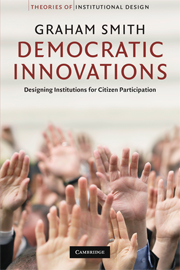Book contents
- Frontmatter
- Contents
- Acknowledgments
- Introduction
- 1 Studying democratic innovations: an analytical framework
- 2 Popular assemblies: from New England town meetings to participatory budgeting
- 3 Mini-publics: assemblies by random selection
- 4 Direct legislation: direct democracy through the ballot box
- 5 E-democracy: the promise of information and communication technology
- 6 Realising the goods of democratic institutions
- Conclusion
- References
- Index
4 - Direct legislation: direct democracy through the ballot box
Published online by Cambridge University Press: 19 January 2010
- Frontmatter
- Contents
- Acknowledgments
- Introduction
- 1 Studying democratic innovations: an analytical framework
- 2 Popular assemblies: from New England town meetings to participatory budgeting
- 3 Mini-publics: assemblies by random selection
- 4 Direct legislation: direct democracy through the ballot box
- 5 E-democracy: the promise of information and communication technology
- 6 Realising the goods of democratic institutions
- Conclusion
- References
- Index
Summary
Direct legislation is intuitively appealing for democrats, since citizens gain effective control over political decision-making, with each citizen having equal power to affect decisions through binding votes. Direct legislation has a long heritage: since 1848, Swiss citizens have had a binding vote on constitutional amendments proposed by their federal government; in 1874 they gained the right to challenge draft government legislation and force a popular vote; and since 1891 they have been able to offer their own propositions for constitutional change through the introduction of the constitutional initiative. And below the federal level, citizens are involved in a variety of different forms of referendum and initiative in their cantons and localities. Currently Swiss citizens vote on around ten propositions every year. Although there is no federal-level referendum process in the United States, a significant number of states and sub-state polities adopted some form of initiative or popular referendum in the first two decades of the twentieth century. Across the rest of the world, the use of referendum and initiative is generally more irregular.
Given this long heritage, does it make sense to consider direct legislation as a democratic innovation? In at least one sense it does. While the referendum is becoming a more commonplace element in the institutional architecture of advanced industrial democracies, it tends to be used sparingly; for the majority of polities it is not a significant democratic device.
- Type
- Chapter
- Information
- Democratic InnovationsDesigning Institutions for Citizen Participation, pp. 111 - 141Publisher: Cambridge University PressPrint publication year: 2009



